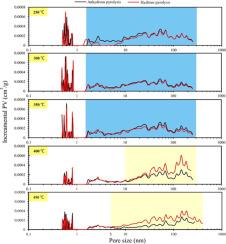水引起纳米级孔隙变化的机理:无水热解与含水热解的影响
IF 6.3
3区 综合性期刊
Q1 Multidisciplinary
引用次数: 0
摘要
以鄂尔多斯盆地三叠系延长组长7段页岩为研究对象,在250 ~ 450℃范围内进行了72 h的人工热成熟实验,并通过岩石热解、低压N2/CO2吸附、傅里叶红外光谱(FTIR)和水溶性有机酸(WSOAs)实验全面探讨了水在有机质(OM)转化和纳米尺度孔隙度变化中的作用。结果表明:岩石热解参数(Tmax、S1和S2)、TOC含量、WSOAs和孔隙体积(PV)在350℃以下变化不大,而在400℃以上(无水和有水)两种不同热解条件下,这些参数变化较大,表明400℃以后OM转化和沥青裂解加速。与无水热解相比,有水热解的Tmax总是更小,这意味着水可以抑制OM的热进展。此外,有水热解的S1比无水热解的S1高约2倍,无水热解的S1来源于水,提供了外源氢气,生成了过量的碳氢化合物,提高了OM的转化率。有水热解的WSOAs是无水热解的2 ~ 4倍,说明水的存在可以通过抑制含氧官能团的缩聚和羟基自由基氧化有机组分来提高有机酸的产率。此外,在350℃以下,热解页岩残渣在加水热解过程中PV值略小,这主要是由于沥青的填充作用。而超过400℃时,有水热解条件下低压N2吸附得到的PV值是无水热解条件下的2倍,这是热裂解、有机酸溶解等净PV增加反应的结果。此外,在无水热解过程中,含氧官能团的缩聚反应和碳-碳交联反应可被认为是释放氢源的两种主要反应途径。综上所述,水的存在对有机质各阶段热演化过程中的生烃和孔隙演化具有重要意义。本文章由计算机程序翻译,如有差异,请以英文原文为准。

Mechanism of water-induced alterations to nanoscale pores: Implications from anhydrous versus hydrous pyrolysis
In this study, shale samples from the Chang7 Member of Triassic Yanchang Formation in Ordos Basin, China were used to conduct artificially induced thermal maturity experiments from 250 °C to 450 °C for 72 h. The role of water in organic matter (OM) conversion and nanoscale porosity alterations were discussed comprehensively by Rock-Eval pyrolysis, low pressure N2/CO2 adsorption, Fourier transform infrared spectroscopy (FTIR) and water-soluble organic acids (WSOAs) experiments. Results show that Rock-Eval pyrolysis parameters (Tmax, S1, and S2), TOC content, WSOAs and pore volume (PV) show slight changes below 350 °C while these parameters were considerably altered above 400 °C under two different pyrolysis conditions (anhydrous and hydrous), indicating that after 400 °C, the OM conversion and bitumen cracking will accelerate. In comparison to anhydrous pyrolysis, hydrous pyrolysis always has smaller Tmax, implying that water could inhibit OM thermal progression. Moreover, S1 of hydrous pyrolysis is approximately two times higher than that of anhydrous pyrolysis, which originates from water providing an exogenous source of hydrogen to generate excessive volumes of hydrocarbons, enhancing the conversion rate of OM. The WSOAs are 2 to 4 times greater under hydrous pyrolysis than anhydrous pyrolysis, denoting that the presence of water could improve the yield of organic acids via inhibiting the polycondensation of oxygen-containing functional groups and oxidizing organic components by hydroxyl radicals. Moreover, below 350 °C, pyrolysis shale residues exhibit a slightly smaller PV in hydrous pyrolysis, mainly due to the infilling effect of bitumen. However, exceeding 400 °C, PV that was obtained from low pressure N2 adsorption under hydrous pyrolysis conditions is found to be two times as large as the value under anhydrous pyrolysis conditions, which is attributed to the net-PV increase reactions such as thermal cracking, and the dissolution of organic acids. Furthermore, in anhydrous pyrolysis, the polycondensation of oxygen-containing functional groups and the carbon-carbon cross linking could be considered as the two main reaction pathways to release the sources of hydrogen. Collectively, the presence of water is significant for hydrocarbon generation and porosity evolution during thermal progression of OM at various stages.
求助全文
通过发布文献求助,成功后即可免费获取论文全文。
去求助
来源期刊

Fundamental Research
Multidisciplinary-Multidisciplinary
CiteScore
4.00
自引率
1.60%
发文量
294
审稿时长
79 days
期刊介绍:
 求助内容:
求助内容: 应助结果提醒方式:
应助结果提醒方式:


